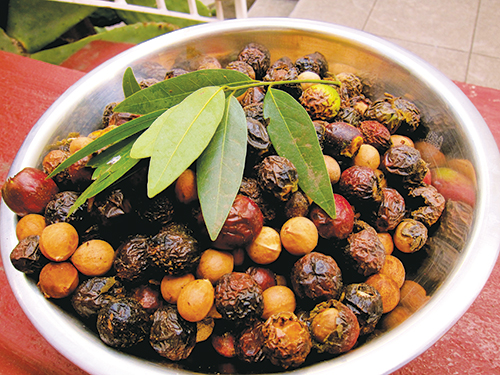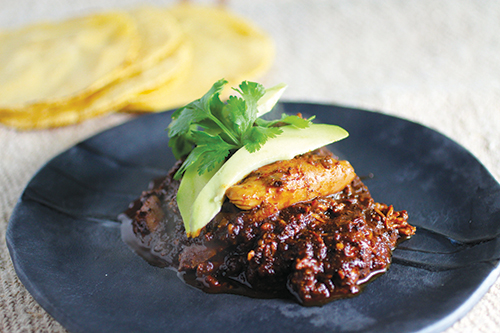ROASTED BAY NUTS
Northern California’s indigenous “cacao”
Story, photos, and recipe by Kristen Rasmussen

An unripe bay nut is covered in bright green flesh. That flesh should be peeled off a ripe nut when processing. (Notice how a ripe bay nut resembles an avocado.) Perfectly roasted bay nuts turn a rich brown, while over-roasted nuts turn a dark blackish color and their oil starts seeping.
You can’t go far on a Bay Area trail without coming across Umbellularia californica, the California bay laurel tree. A native of the Pacific West, it’s a close cousin to the Mediterranean tree Laurus nobilis, which produces the bay leaves we buy at the store. Many people cook with wild bay leaves in lieu of store-bought, but they learn to use them in moderation, as they are quite a bit more pungent.
However, the real culinary gems of this ubiquitous plant are the bay nuts. Foragers start gathering them here in October, but in hotter climes (or even here in the bay Area, with this crazy weather we’ve been having), the nuts might be falling from the trees as early as September. The flavor of the roasted bay nut evokes a combination of coffee and dark chocolate and offers a dessert-like decadence rarely found in foraged plants. It’s simply and consistently a wild-edible crowd pleaser.
This dark and mysterious seed is actually a close relative of the avocado: When fresh, it resembles an avocado pit with a thin layer of green flesh around it. The flesh changes from a bright green when young to purple when ripe, and the whole fruit is technically edible (although it rots very quickly).
Before roasting, bay nuts have a strongly astringent and bitter flavor, like that of uncured olives or acorns, and should not be consumed. After proper roasting, the nuts can be used creatively in many ways—such as in a mole or ricotta cheesecake—or simply eaten on their own. (Try them with whiskey around a campfire!)
Bay nuts have stimulating compounds similar to caffeine, and if eaten in large quantities they may cause digestive issues for some people. Like with all new foods, it’s a good idea to consume with caution at first.
Foraging and Processing
Bay nuts can be collected right off the ground. You’re likely to find the outside flesh to be brown and soft, but sometimes you can find the nuts without the flesh, which is even better. Do not pick up nuts that look moldy. To process them, peel off the flesh and continue to discard any nuts that are rotten. Wash the nuts, removing any excess goop, and lay on a cloth towel or baking sheet to allow any remaining moisture to evaporate. Complete the drying process by storing in a dark place for two weeks. Bay nuts should be stored in an open bowl or jar or in paper bags. You can store them like this for up to two years.
Roasting and Eating
Roast the nuts at 350° on a baking sheet in a single layer. Roasting usually takes about 1 to 1½ hours, but you’ll know they’re done when the insides look brown/black. (Some nuts will crack open, so this should be easy to see.) Alternatively, you can up the temperature to as high as 450° and bake for 45 minutes. Either way works, just check them every 30 minutes. When they’re done, you can crack open the shells with a nutcracker and enjoy the nuts in any way you choose.
Try the recipe below and also the Bay Nut Truffles in our Winter 2020 issue.
Bay Nut Chicken Mole
Traditionally, moles get their robust coffee-cacao flavor from chocolate, but roasted bay nuts are a great alternative for a similar rich-but-wild flavor.
Serves 6
2½ pounds skinless chicken thighs and/or legs
1–2 teaspoons salt (or to taste)
2 tablespoons grapeseed (or other neutral flavored) oil, divided
1½ cups low-sodium chicken broth
Juice and zest from 2 blood oranges
2 cinnamon sticks
1 yellow onion, chopped
¼ cup almonds, chopped
3 large garlic cloves, diced
2 teaspoons cumin seeds
2 teaspoons coriander seeds
1½ ounces dried pasilla chiles, stemmed, seeded, and torn into strips
½ ounce dried negro chiles, stemmed, seeded, and torn into strips
3 prunes, chopped
1 teaspoon dried oregano
2 ounces roasted bay nuts, chopped (Mexican chocolate can be substituted for bay nuts, brown sugar, and cinnamon)
1 tablespoon brown sugar
Chopped fresh cilantro, queso fresco, avocado, and corn tortillas (to serve)
Rub chicken all over with salt. Heat 1 tablespoon oil in large pot over medium-high heat. Brown chicken (about 3 minutes per side).
Add broth, blood orange juice, and cinnamon sticks then bring to a boil. Reduce heat to medium-low, then cover and simmer until chicken is tender and just cooked through, about 25 minutes.
Meanwhile, heat remaining 1 tablespoon oil in large saucepan over medium heat. Add onions and garlic and sauté until softened and beginning to caramelize, about 10–12 minutes, stirring occasionally.
Add almonds, cumin, coriander, and chiles. Reduce heat to medium-low and cook while stirring until chiles soften, about 4 minutes.
Using tongs, transfer chicken from pot to a large bowl. Pour chicken cooking liquid into saucepan with onion-chile mixture. (No need to wash the pot, since you’ll use it again shortly.) Add blood orange zest, prunes, oregano, bay nuts, and brown sugar to saucepan. Cover and simmer until chiles are very soft, stirring occasionally, about 30 minutes. Remove and discard cinnamon sticks.
Transfer sauce mixture to a food processor or blender and purée until smooth; return to reserved pot. Season sauce to taste with salt. Coarsely shred chicken and return to sauce; stir to coat and re-heat chicken.
Serve over homemade corn tortillas topped with cilantro springs, avocado, and queso fresco (as desired). The dish pairs well with vinegary red cabbage slaw (the vinegar is a great contrast to the dark, rich mole) and roasted delicata or butternut squash.




[…] To process them, peel off the flesh and continue to discard any nuts that are rotten. Wash the nuts, removing any excess goop, and lay on a cloth towel or baking sheet to allow any remaining moisture to evaporate. Complete the drying process by storing in a dark place for two weeks. via […]